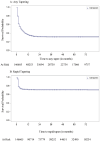Incidence of Opioid Dose Tapering Among Older Adults Enrolled in Medicare
- PMID: 40568411
- PMCID: PMC12188434
- DOI: 10.1093/geroni/igaf028
Incidence of Opioid Dose Tapering Among Older Adults Enrolled in Medicare
Abstract
Background and objectives: Long-term opioid therapy (LTOT) is frequently used for management of chronic noncancer pain, but its associations with increased risks of overdose and mortality have necessitated an evaluation of strategies for tapering or discontinuation. The process of opioid tapering is complex due to associated withdrawal symptoms and potential adverse outcomes. Thus, understanding tapering patterns and associated factors is vital for optimizing pain management, especially for vulnerable older adults.
Research design and methods: This cohort study used the 5% national sample of Medicare administrative claims data from 2012 to 2019. The study cohort consisted of individuals aged 65 and older on LTOT. The key outcomes were time until any tapering or rapid tapering of opioids. Various predictor variables, including sociodemographic and clinical factors, were examined. Survival curves were plotted, and Cox proportional hazards models were used for data analysis.
Results: The study cohort included 146,605 Medicare beneficiaries on LTOT, of which the largest percentages were aged 65-74 years (48.5%), women (68.0%), and non-Hispanic White (82.3%). Within the first year of LTOT use, nearly 1 in 2 individuals experienced any tapering, and about 1 in 4 individuals experienced rapid tapering. Presence of multiple chronic noncancer pain conditions, hepatic impairment, sleep disorders, higher baseline opioid dose, and LTOT initiation after 2016 were associated with increased rate of both any tapering and rapid tapering. The release of the 2016 CDC guideline was associated with a 45% and 64% increase in the hazards of any tapering and rapid tapering, respectively.
Discussion and implications: This study estimated the incidence rate and predictors of opioid tapering among older adults in the United States. Combined with rates of opioid prescribing and prevalence of chronic pain, these epidemiological data are crucial for identifying and improving the safety and effectiveness of pain management among older adults.
Keywords: Cancer; Chronic noncancer pain; Long-term opioid therapy; Opioid tapering.
© The Author(s) 2025. Published by Oxford University Press on behalf of the Gerontological Society of America.
Conflict of interest statement
None.
Figures
Similar articles
-
Opioid Tapering and Opioid Overdose, Opioid Use Disorder, and Mortality Among Older Adults: A Nested Case-Control Study.J Gen Intern Med. 2025 Apr 22. doi: 10.1007/s11606-025-09492-9. Online ahead of print. J Gen Intern Med. 2025. PMID: 40261495
-
Coprescribing of opioids and psychotropic medications among Medicare-enrolled older adults on long-term opioid therapy.J Am Pharm Assoc (2003). 2023 Nov-Dec;63(6):1753-1760.e5. doi: 10.1016/j.japh.2023.08.019. Epub 2023 Aug 24. J Am Pharm Assoc (2003). 2023. PMID: 37633452
-
A rapid and systematic review of the clinical effectiveness and cost-effectiveness of paclitaxel, docetaxel, gemcitabine and vinorelbine in non-small-cell lung cancer.Health Technol Assess. 2001;5(32):1-195. doi: 10.3310/hta5320. Health Technol Assess. 2001. PMID: 12065068
-
Pain management for women in labour: an overview of systematic reviews.Cochrane Database Syst Rev. 2012 Mar 14;2012(3):CD009234. doi: 10.1002/14651858.CD009234.pub2. Cochrane Database Syst Rev. 2012. PMID: 22419342 Free PMC article.
-
Hydromorphone for neuropathic pain in adults.Cochrane Database Syst Rev. 2016 May 24;2016(5):CD011604. doi: 10.1002/14651858.CD011604.pub2. Cochrane Database Syst Rev. 2016. PMID: 27216018 Free PMC article.
References
-
- Karmali RN, Bush C, Raman SR, Campbell CI, Skinner AC, Roberts AW.. Long-term opioid therapy definitions and predictors: A systematic review. Pharmacoepidemiol Drug Saf. 2020;29(3):252–269 https://doi.org/ 10.1002/pds.4929 - DOI - PMC - PubMed
-
- Chou R, Turner JA, Devine EB, et al. The effectiveness and risks of long-term opioid therapy for chronic pain: A systematic review for a National Institutes of Health Pathways to Prevention Workshop. Ann Intern Med. 2015;162(4):276–286 https://doi.org/ 10.7326/M14-2559 - DOI - PubMed
-
- Ramachandran S, Salkar M, Bentley JP, Eriator I, Yang Y.. Patterns of long-term prescription opioid use among older adults in the United States: A study of Medicare administrative claims data. Pain Physician. 2021;24(1):31–40. https://doi.org/ 10.1016/j.jpain.2014.05.009 - DOI - PMC - PubMed
-
- Salkar M, Ramachandran S, Bentley JP, et al. Do formulation and dose of long-term opioid therapy contribute to risk of adverse events among older adults? J Gen Intern Med. 2022;37(2):367–374 https://doi.org/ 10.1007/s11606-021-06792-8 - DOI - PMC - PubMed
-
- Dunn KM, Saunders KW, Rutter CM, et al. Opioid prescriptions for chronic pain and overdose: A cohort study. Ann Intern Med. 2010;152(2):85–92 https://doi.org/ 10.7326/0003-4819-152-2-201001190-00006 - DOI - PMC - PubMed
Grants and funding
LinkOut - more resources
Full Text Sources


